On a clear day in Seattle, you can see the ancient face of Tahoma or Ta Ko Ba (təqʷuʔmaʔ), craggy and snow-capped, at once close and far away. On maps and postcards today, she’s called Mount Rainier, renamed in 1872 by a British Royal Navy officer. But before then, Tahoma was a lifeline to millions of Indigenous people.
At 14,410 feet, Tahoma is the highest volcanic peak in what is now known as the contiguous United States. Many parts of the mountain feel wild, but she’s not unaccustomed to human activity: For millennia, Native groups—including the Coast Salish, Cowlitz, Muckleshoot, Nisqually, Puyallup, Squaxin Island and Yakama peoples—were her close companions, gathering berries and hunting game on her slopes; fishing in her cool, clean water; and collecting cedar to make baskets, regalia, hats and children’s toys.
Today, however, there are few Indigenous visitors to the mountain. After President McKinley designated Mount Rainier as the fifth national park in 1899, Indigenous presence there declined, and white mountaineers and international visitors began dominating recreation in the area. The mountain’s first documented summit was in 1870 by two white Americans; to date, according to Muckleshoot climber Rachel Heaton, there have been no known successful summits by an Indigenous woman. She’s setting out to change that.
Heaton is now the leader of a group of six other climbers, representing a range of Indigenous identities, who have spent time training and preparing themselves to venture far up Tahoma as they can, quite possibly for the first time in recorded history. In early September of 2023, they reached 12,000 feet together, stopped short of summiting by deteriorating route conditions. But their mission is not simply to reach the top: They want to increase Native visibility on the mountain and raise awareness for the ancient relationship between Tahoma and the Indigenous peoples who honor her.
Read on for Rachel Heaton’s story.
Jump ahead for an introduction to the other climbers and a list of the REI Co-op gear that aided them on their voyage.
Living and Connecting Outdoors
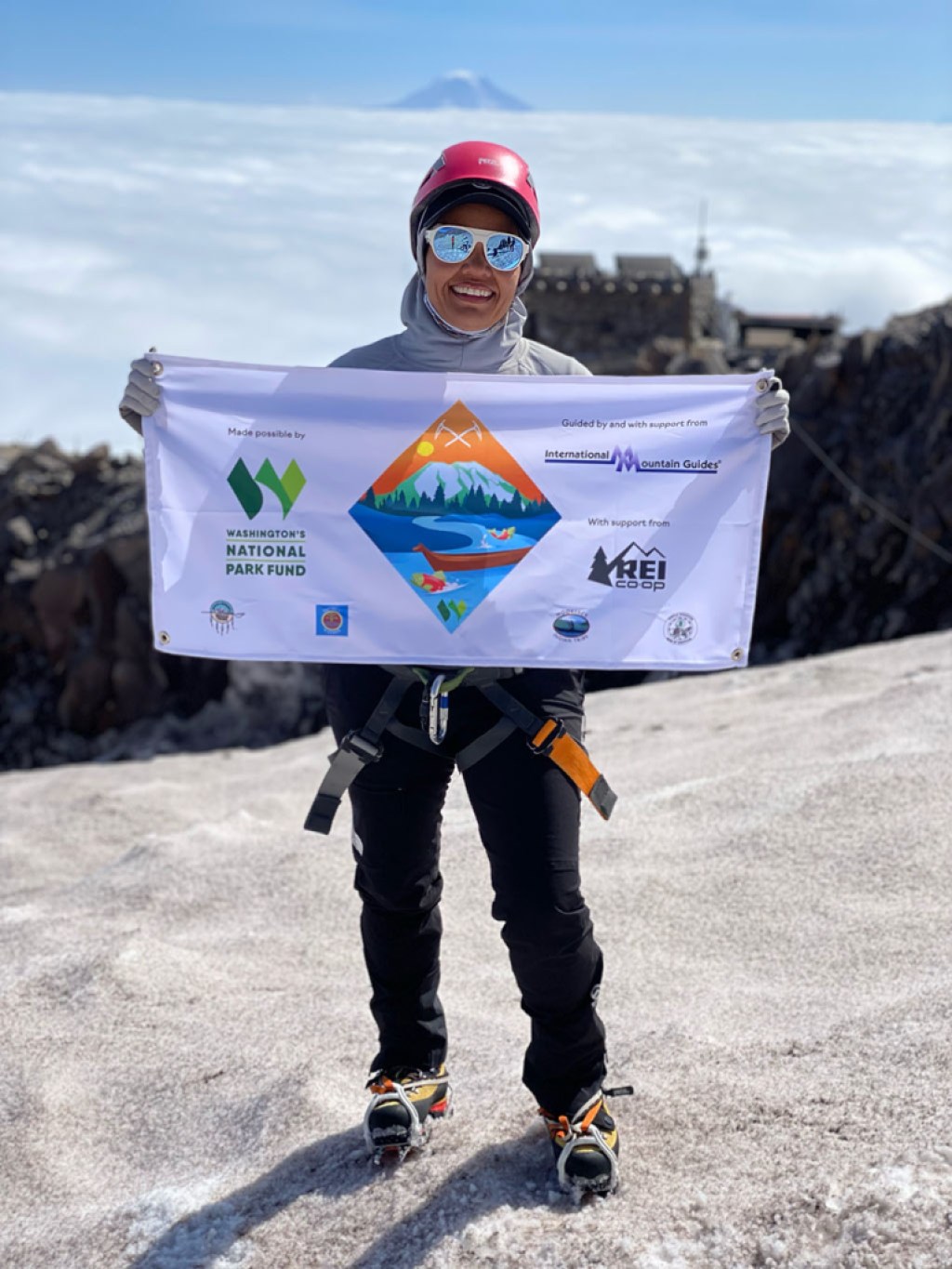
My name is Rachel Heaton. I’m a Muckleshoot tribal member and a descendant of the Duwamish people. My mom is Native, and my dad is Irish and Welsh. First and foremost, I’m a mom. I have 24-year-old and 17-year-old daughters and a 5-year-old son.
Day-to-day, I’m a cultural educator for my community here at Muckleshoot. The tribe owns about 96,000 acres at the base of Mount Rainier, which is Tahoma or Ta Ko Ba to us, and I get to take the community outside and connect them to the land. I talk about plant medicines, and how to bring tribal food sovereignty into our homes by utilizing our native plants.
I also have what’s called an “earth gym.” I work youth out using the land: squatting down on a log, throwing rocks over a tree stump or bending over and picking up heavy objects—we use what’s outside. Bringing these kinds of things back into our homes is important for cultural sustainability, as is maintaining our practices that have been lost through generational trauma, assimilation, residential schools—the list goes on. I’m a strong believer in protecting Mother Earth for the seven generations ahead, and I believe the best way for us to do that is through connecting people to the land. Because how can you protect something that you’re not connected to? The only way you can get connected to that is by getting outside.
I grew up in Georgia in the ‘80s, and my parents sent my siblings and me outside often to play. If we were outside, it meant that we weren’t in trouble, we weren’t doing chores—we were with our friends. It was never organized in the sense of my family hiking or any of those kinds of things. But, we were always outside, whether it was wandering through the trailer park or waiting for the pool to open in the summer or walking through the neighborhoods.
Despite growing up outside, I never considered climbing a mountain before this. Mountaineering isn’t something my people have been doing, in part because national parks were actually created to move Indigenous people out of those spaces. They’ve done a really great job of keeping us out. For me, I didn’t see myself out there. There was nobody who looked like me.
Meeting the Mountain
Initially, the mountain didn’t “call me.” I was a competitive bodybuilder, but when I found out I was pregnant with my son, I didn’t feel like I could just pack my bag and go to the gym. But I thought, “Exercise is resistance plus cardio. My son’s going to be my resistance, and we’re going to get outside and hike.” Mind you, I didn’t know anything about hiking. I didn’t know how to find the trail or how to navigate it.
Snoqualmie Falls was the first hike I did with my son, when he was 6 weeks old. We hiked to the bottom and back with him in his little pack, and I thought, “That was a good challenge.” That first hike gave me some confidence. At first, it was always me and him. Then I started looking online for local trails, and then I started inviting people to go out with us. We had 20 people on some hikes. They were looking for connection just like I was looking for my own peace.
Me and my son’s hikes gradually got longer: 2-mile hikes turned into 5-hour hikes, and then our 5-hour hikes turned into overnight camping trips, and then those turned into multiple days on the mountain. The more we got out there to hike, the more I realized, “I never run into any Natives out here.” It got me wondering, why are we not out hiking when the mountain is literally our backyard?
I started asking around, “Do you know of any tribal members who had ever summited? Do you know of any tribal people who had been out there?” And I kept hearing no. I told my significant other, “I think I’m going to attempt to summit next year.” That was in August of 2021, and in October of 2021, I signed up for a June 2022 climb.
I thought, “I was a bodybuilder, I’ve been in the best shape of my life, I can go climb a mountain.” That was dumb shit. It was nothing like bodybuilding! I know cardio and I know endurance, and I knew those things were needed, but I had no clue that the training base that I had was nothing like the base that I needed for this. I basically jumped in the deep end. Three days into my first attempt, I had to turn around and come back. My ego kicked in because I never imagined not completing it. It wasn’t so much about not making it to the top: The true goal of the climb was revisiting my tribe’s traditional plants, taking our medicines, taking our traditional foods and being able to share them with people visiting the mountain. To go back down felt like a walk of shame. There was nothing that YouTube taught me to get me ready for that.
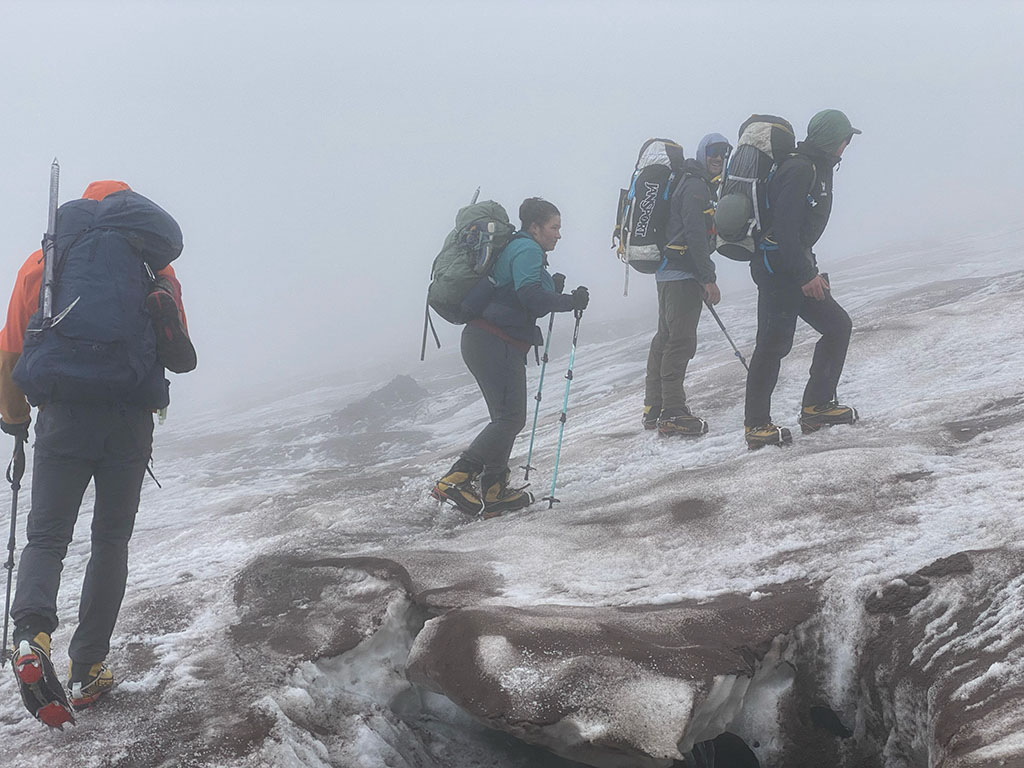
So, I wouldn’t say the mountain called me, but in the bigger picture, she did in a way. I always tell people, “I have a relationship with the mountain.” She knows me, and I believe that. We were present on Tahoma before it became a national park. We used to travel over those mountains to get to other reservations; we had berry camps, and what are now called “archaeological sites,” showing what we’ve always known: that we were present on the mountain.
But I’m not conquering the mountain. There were people for thousands and thousands of years who were climbing there way before any of us were recording. To say that you’ve conquered something is a very patriarchal behavior. You’re not conquering it: You’re getting the privilege to actually explore spaces that not everyone gets the opportunity to. You get to experience healing if you allow the mountain to do that.
This isn’t about the peaks. It’s about my people. I want to create visibility for us on the mountain.
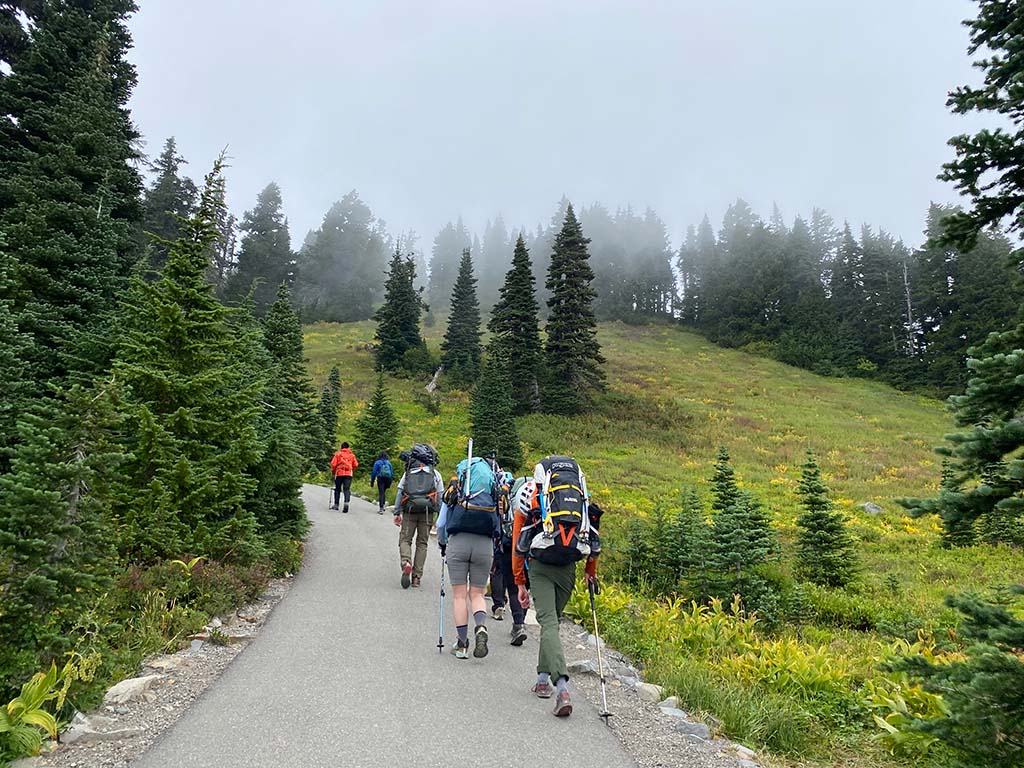
My team is awesome. Every one of us is Native. No one has mountaineering experience. We’re all different in our own way, but our chemistry is amazing. We support each other, balance each other out. We all came together organically: I didn’t advertise that I needed climbers, everyone basically just heard about the climb somehow and came to me, saying they were interested. I feel like the people who are supposed to be on this climb are on this climb.
Meet the Other Climbers
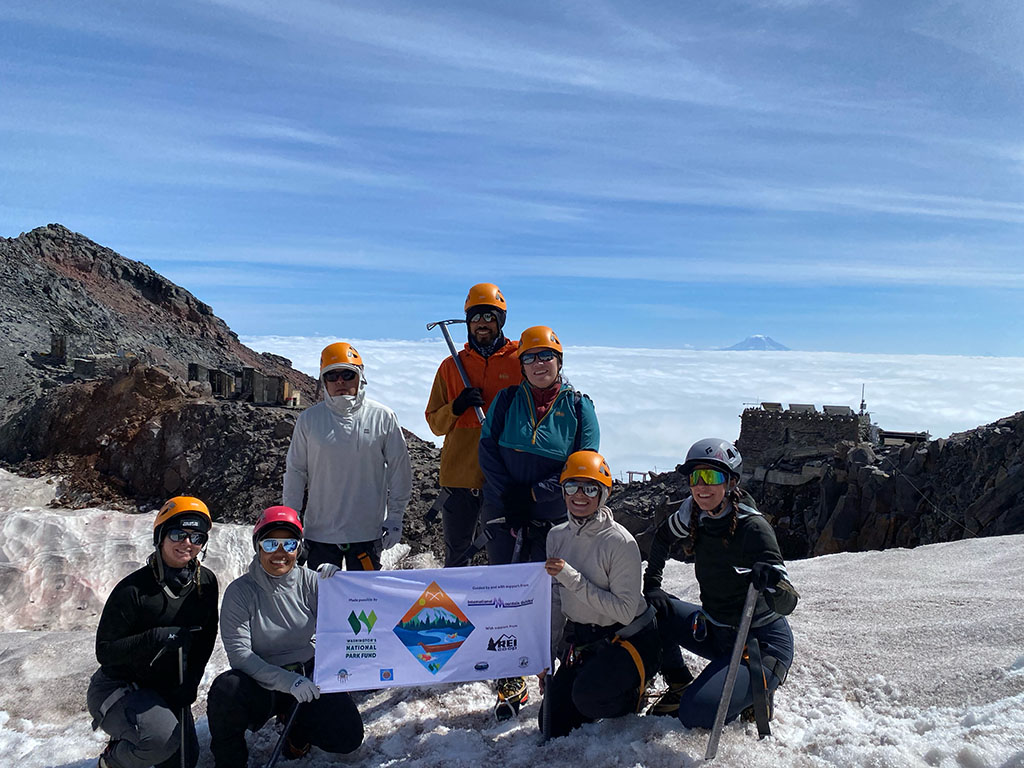
Gil Adame is a Muckleshoot Tribe member and works as a Juvenile Healing to Wellness Coordinator for the tribe. He is also Rachel Heaton’s partner and the climb’s documentarian.
Adame says, “Not one bit of me wanted to climb a mountain ever in my life. I’ve looked at that mountain a million times and never thought, ‘One day, I’d like to do that.’ I always mess around with Rachel and say, ‘Hey, your man’s climbed a mountain for you.’ The whole goal of my purpose in it is so my kid and their friends, and their friends’ friends, can talk about it and understand that we do—and we can do—stuff like this. My first time in the back of a cop car was at age 9, and I was in juvenile hall for the first time at 13. I spent 11 years of my life locked up, and I never thought I would have something that I could give back. But I can do something great. I can make it to the top.
There’s a lot of good things besides the mountain going on for us too. After the climb, we’re going to start up our own 501(c)3 for people like me, who had that lifestyle and don’t know how to change. Connecting to the land and getting out there, getting outside whether it’s just going for a walk, bike ride, kayaking—that’s part of what’s keeping me grounded, and I wish that more of our kids had that.”
Rita Gray is a member of the Turtle Mountain Chippewa Tribe, is a Bill Gates Millennium Scholar and holds a Master of Education in Curriculum and Instruction.
Rita Gray says, “I grew up in low-income housing and was never exposed to anything outdoor-related. I never would have thought that I would become a frequent hiker, let alone summiting Mount Tahoma! I grew up playing volleyball and basketball and never did any outdoor sports. When Steven and I were in our early twenties, we started occasionally hiking and ran a half marathon. I started to have an interest in learning from the land when I became a curriculum developer for the Muckleshoot Indian Tribe. In the last five years, I have become a more frequent hiker and really enjoyed harvesting traditional plants and learning from the land. I have no mountaineering experience and my only experience is recreational hiking.
I am from the Turtle Mountain Chippewa Tribe, and my Indigenous family come from North Dakota. However, I was born and raised in Kent and Federal Way, Washington. I have always loved seeing Mount Tahoma and exclaiming, ‘The mountain is out.’ Four years ago, Steven and I bought a house with property that has a mountain view. I have come to really appreciate her in a different light since joining the Indigenous climbing group. While Mount Tahoma is not on my ancestral land, I am grateful to learn from her. There is a traditional story about Mount Tahoma and how she is the giver of life. The first time I heard that story was a life-changing moment for me. Mount Tahoma is magical and provides so much for all of us in this area.”
Steven Gray, Rita’s husband and fellow climber, is Afro-Indigenous and a member of the Nooksack Tribe. Steven is a retired professional basketball player and now works as the athletic director for the Muckleshoot Tribal School.
Steven Gray says, “Growing up in the PNW, visions of Tahoma fill my memories. Hours spent in the car on trips to see family I would stare out of the window, my thoughts lost somewhere on the mountain. As my wife mentioned, we now have a house with a view of Tahoma and I remember the first thunderstorm I experienced early one morning. I was humbled by the power of the thunder rolling down. I felt very connected to the land that day. And to know my relatives and ancestors felt those same connections makes this journey extremely special.
“Phillip Henderson gave us a piece of advice that I want to carry through life. He told us on a visit with some members of our group not to ask people on the way up if they reached the summit. By doing that, we are missing the point, we do a disservice to all the work, preparation, sacrifices and ultimately the growth that occurs as an individual to get to that point on the mountain. It’s truly about the journey not the destination.”
Mercedes Sosa is a member of the Muckleshoot Tribe and of Argentine descent. She is Rachel Heaton’s eldest daughter, and is a certified personal trainer, educator and licensed master esthetician. After finishing the climb with the group, Sosa says: “This climb was very challenging, I did not realize how much mental vs physical strength I would need to get to just Camp Muir. I did train for months before the hike, but nothing could’ve prepared me for what it took just to get to Muir and the day to day. I loved our guides. They provided so much knowledge and a lot of calmness for our team. I know in some way we were all fighting an internal battle of our own. This experience will live with me forever, I can’t wait to do it again next year. Because of our hike, we have inspired so many people.”
Tayla La Clair is a Muckleshoot Indian Tribe member and works as a certified personal trainer at the Muckleshoot Health and Wellness Center. She is also a certified senior fitness specialist (SFS) through the National Academy of Sports Medicine.
Jennifer Vickers is of Nipmuc, Narragansett and European descent. Jennifer was born in Worcester Massachusetts and comes from the FreshWater and Coastal Peoples of the Eastern Woodlands. As an infant, she moved with her family to Seattle, where she was raised on the traditional lands of the Coast Salish. She graduated from Garfield High School and Indian Heritage High School as an accomplished athlete in volleyball and softball.
“Save our salmon!” was Vickers’ tribal mission at the idealistic age of 17 upon being the first female in her family lineage to receive a high school diploma and explore the possibility of being a marine biologist. Unfortunately, as is the case for most Indigenous peoples, without substantial grants or scholarships or tribal stipends, attending college is very hard. This inequity and all-too-familiar disparity of her relatives fueled her passion for activism of Indigenous issues and, ultimately, the well-being of her people. Vickers shares this passion of creating greater public land access for Indigenous people to reconnect with as they once roamed and cared for these lands with respect of reciprocity.
Outside of work, Vickers explores the wilderness in alignment with her Indigenous plant knowledge and traditional healing practices. She shares this love with her two children, Benicio (15) and Vida (9) and partner, George Farrell. To do it all, she maintains a very vigorous exercise and self-care regimen.
Vickers says, “Mountaineering was never on my radar … knowing the ability to make the financial investment in climbing was never likely to happen. Then, three years ago, I told my children, ‘I will climb Tahoma before I am 50.’ I just had to put it into the universe to decide and see what was to come. I am deeply humbled and beyond grateful for this opportunity, my climbing team, the sponsorships that prepared us and made sure we were safe and warm, and that we were guided by the best people possible at IMG! The entire experience will remain unforgettable. Kuttabottomish. (Thank you.) All My Relations.“
What’s In the Climbers’ Kits?
Mountaineering can be an intimidating and expensive sport: It requires specialized knowledge preparation and training, and the cost of gear and apparel can be a barrier to entry for folks, especially from marginalized communities. Heaton says, “When I got introduced to the mountaineering world, I learned there’s a mid layer and a base layer and a soft layer and a hard layer—and now I can go dressed for any weather. But before then, I had no clue.” She also says she “spent well over $15,000 just trying to get into mountaineering, testing out different things and paying for climbs, just trying to get out there. Not everybody has the ability to do that.”
At REI Co-op, we know we go further together. To that end, REI, Patagonia, Washington’s National Park Fund and International Mountain Guides (IMG) have partnered with Heaton and her climbers to offer financial support, training, and gear and apparel to help them on their journey.
“Indigenous people only make up 5% of the population, yet we protect the most biodiversity in the entire world—and to me, that says that we can’t do that work alone,” Heaton says. “Folks like myself believe in allyship. There’s definitely people who want to work with us in that way.”
Funding from Washington’s National Park Fund and REI Co-op made the trip—including permitting and other preparations—possible. IMG provided experienced guides to aid the climbers on their trek. Patagonia supplied the climbers’ hard-shell outerwear.
Here’s a list of gear and apparel from REI that the group took up with them.
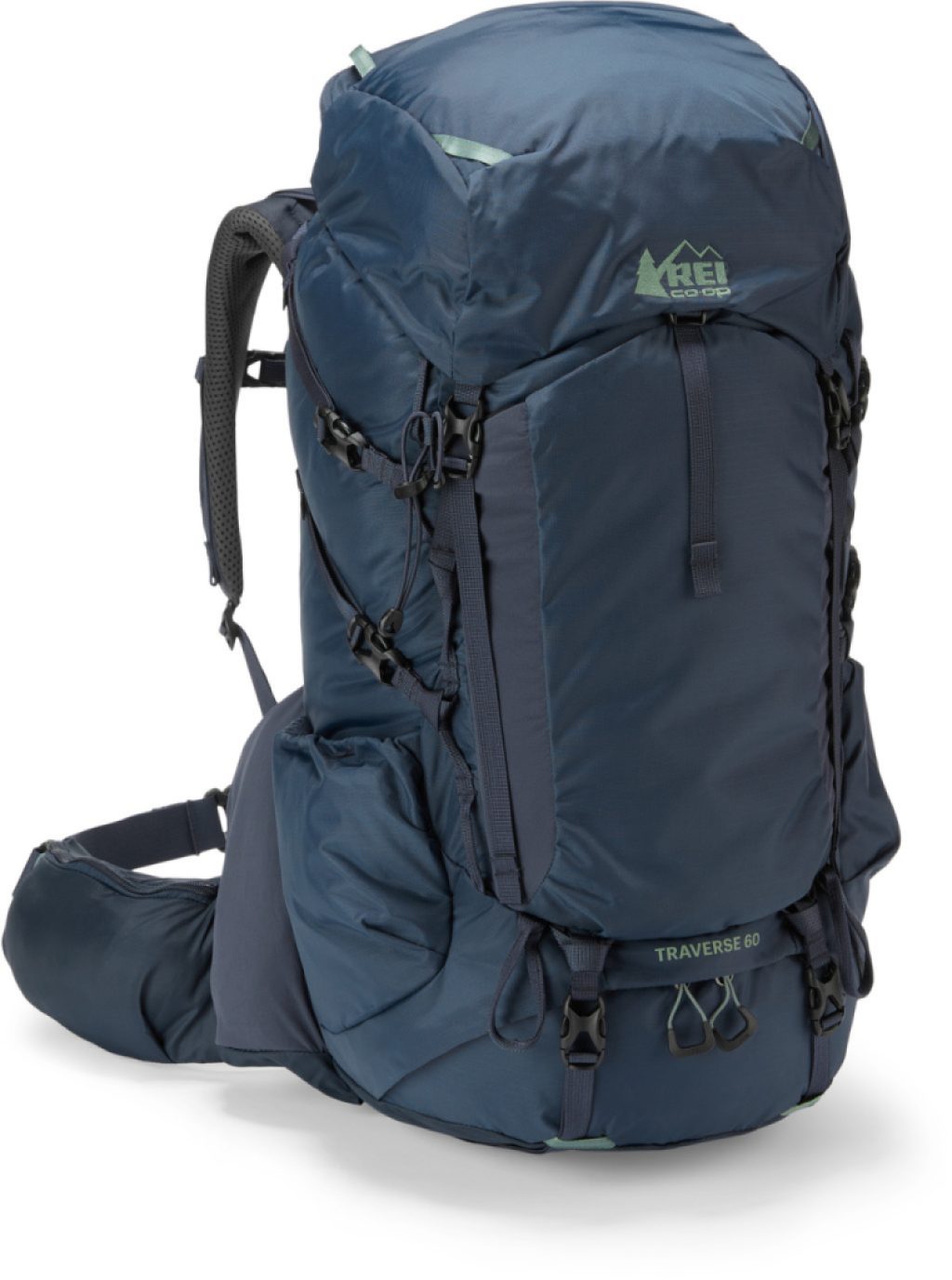
REI Co-op Traverse 60 Pack
The climbers need durable packs that fit comfortably and offer ample capacity: The Traverse 60 is made from bluesign®-approved ripstop nylon, holds up to 62 liters of gear and features continuous padding from the hipbelt through the lumbar. Available in men’s and women’s. $229
REI Co-op Swiftland Running Shirt
This super lightweight technical top is made from moisture-wicking and fast-drying SwiftTex™ material, with gusseted underarms for easy movement and flat seams to avoid chafing. Available in men’s and women’s. $39.95


REI Co-op Midweight Base Layer Half-Zip Top
A midweight base layer is a must for hikes at higher elevation: This flat seam long-sleeve top offers next-to-skin insulation and sun protection, thanks to its UPF 50+ recycled polyester/spandex fabric (bluesign®-approved). Available in men’s and women’s. $59.95
REI Co-op Flash Insulated Hybrid Hoodie
The average high temperature at the top of Tahoma is just about 60°F in late summer, with overnight lows in the forties The team needs layers that will block wind and precip and allow them to move freely without creating a lot of extra bulk. This windproof hooded zip-up layer insulates when damp and stuffs into its own hand pocket. Available in men’s and women’s. $179


REI Co-op Trailmade Anorak Softshell
Double-weave stretch nylon makes this softshell layer breathable and windproof, and articulated elbows allow for range of motion even when it’s zipped over several layers. The deep half-zip front means easy-access ventilation, and roomy pockets help keep snacks and necessities handy. Available in men’s and women’s. $99.95
REI Co-op Activator 3.0 Softshell Pants
If the team encounters any wind, these pants will be invaluable: They’re wind-resistant up to 35 mph and are a softshell bluesign®-approved nylon/polyester/spandex fabric that’s durable, breathable and stretchy—and it will stay dry in rainy conditions. Available in men’s 30” inseam, men’s 32” inseam and men’s 34” inseam; and women’s, women’s petite sizes, women’s plus sizes and women’s tall sizes. $99.95
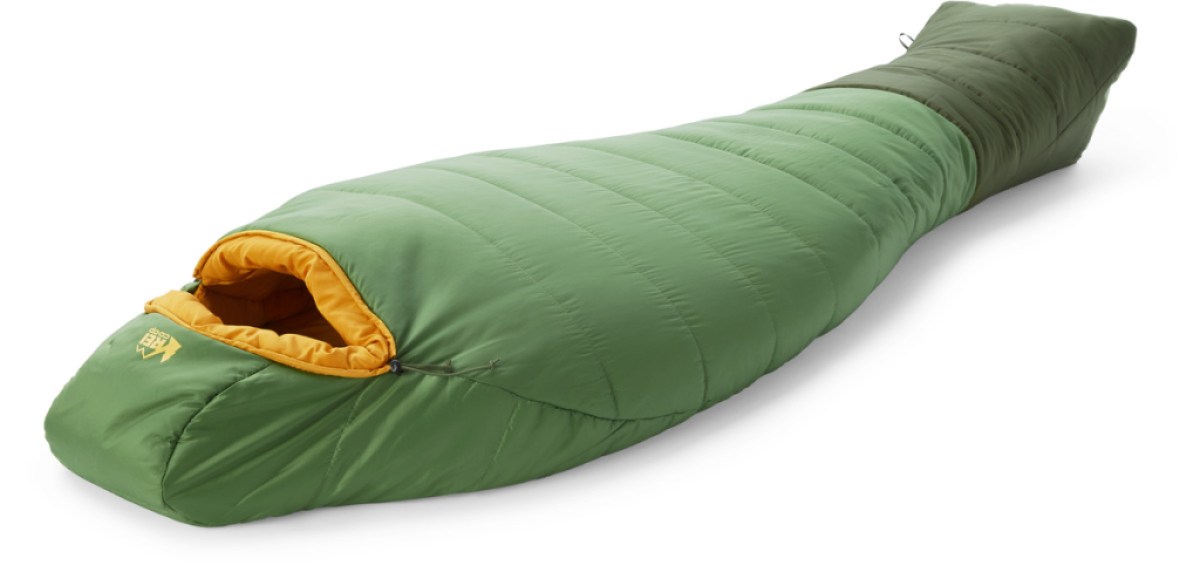
REI Co-op Trailmade Sleeping Bag
On a trek like this, a good night’s sleep can make or break morale. This water-resistant sleeping bag weighs just over 3 pounds, packs into its own stuff sack and features a face muffler and full draft tube for extra coziness and protection. $99.95


